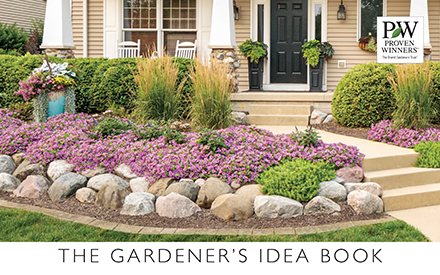Sedum - The Ultimate Growing Guide from Proven Winners®
Sedum is an easy-to-grow succulent that comes in a range of sizes, colors and forms. For long-lasting color in the garden, it’s hard to beat the durability and toughness of this hardy perennial.
Buy sedum plants – Order perennials online and have them shipped right to your door
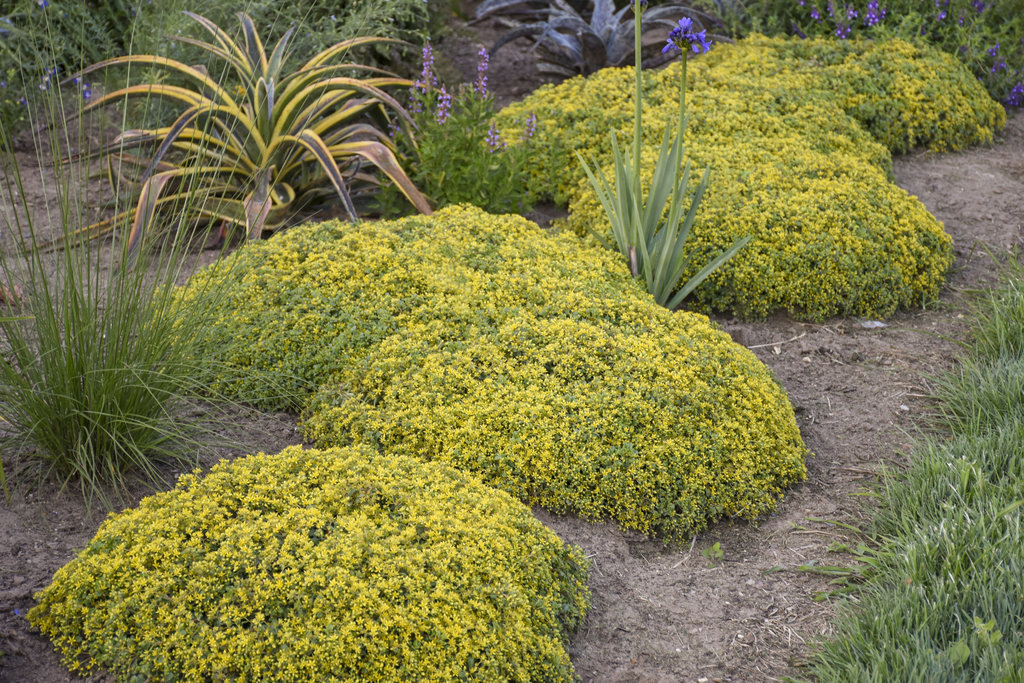
Grown for the fleshy succulent leaves in an array of colors and patterns, sedums produce star-shaped flowers that attract butterflies and other insect pollinators. The upright or creeping habit is useful when planted in mixed borders, rock gardens, along slopes or pathways, in mass plantings or curbside strips. Sedums bloom from early summer to fall depending on the variety, complementing many other plants with mid to late-season interest.
Hardy in USDA zones 3-11, sun-loving sedums are highly adaptable as long as they have well-drained soil. Tolerant of varying conditions including poor soil and hot dry conditions, they do best in climates that are not overly wet or humid.
PLANTING & CARING FOR SEDUM
How to plant: Choose a sunny spot that receives at least 6 hours of full sun a day. Follow these steps and space 4-28” apart, depending on the type and variety.
- Loosen soil in the planting area.
- Add sand, grit or perlite if the native soil is poorly draining.
- Remove plant from the nursery pot and tease out roots if potbound.
- Set plant in the hole with the top of the root ball level with the surrounding soil.
- Backfill the hole with soil and tamp down lightly to remove air pockets.
- Water regularly until plants are established.
Soil: Sedum is tolerant of poor soil, but does best in average or rocky soil with good drainage. Clay or compacted soil creates standing water, which leads to root rot.
Watering: Sedums store water in their fleshy leaves, which makes them more resistant to drought and dry conditions. Provide supplemental water only in prolonged dry spells or extreme heat. Too much water can cause rot, mushy foliage or disease. Upright types may flop with too much water.
Fertilizing: Sedums do not need supplemental fertilizer. Soil that is too rich can cause weak, leggy growth.
Pruning: Upright sedum varieties can be pinched back in spring to promote compact growth. Stems can be cut back to the ground after the first hard frost or left for winter interest. The faded flowering heads provide winter color and food for songbirds. If plants are left to overwinter, cut back to the ground in early spring before new growth emerges. Groundcover types can be trimmed as needed if they outgrow their space.
SEDUM PLANT TYPES
Here are the most commonly grown types of sedum:
Creeping sedum is a groundcover type that can sprawl up to 3 feet wide. Foliage is green, yellow, red, blue, silver or variegated. The small leaves are rounded or spiky. Star-shaped flowers bloom during summer in colors of yellow, orange, pink or white. There are many species and varieties, including Rock ’N Low™ ‘Boogie Woogie’ and ‘Angelina’.
Tall sedum has an upright growth habit, reaching 1-2 feet tall and wide. Thick, fleshy leaves are green, purple, burgundy or variegated, with star-star-shaped flowers occurring in shades of pink, purple or white. Varieties include Rock ’N Grow® ‘Lemonjade’.
Trailing sedum can be used in hanging baskets and containers, or to spill over rock walls or troughs. Leaves come in colors including green, silver, red, yellow or variegated. Star-shaped flowers can be yellow, pink or white. There are many different varieties, including ‘Kelp Forest’ and ‘Burrito’ burro's tail, which is grown primarily as a houseplant.
TRY THESE PROVEN WINNERS® VARIETIES
Sedums come in a range of forms, flower and foliage colors. Try these in your landscape:
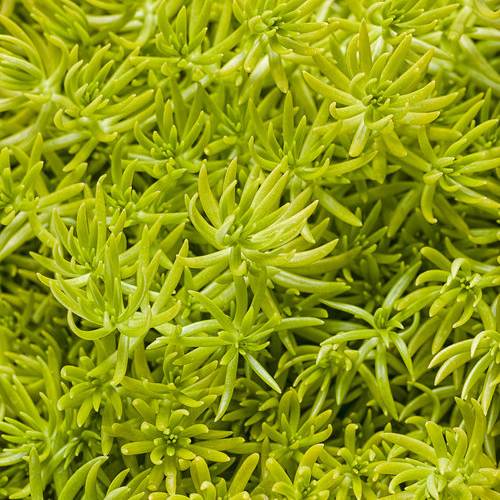 Lemon Coral® is grown for its bright chartreuse foliage, with small spiky leaves that belie its soft texture. The compact spreading habit of this annual or tender perennial is versatile as border or pathway edging, in containers or massed in beds. Tolerates heat and dry soils, but performs best with average moisture. |
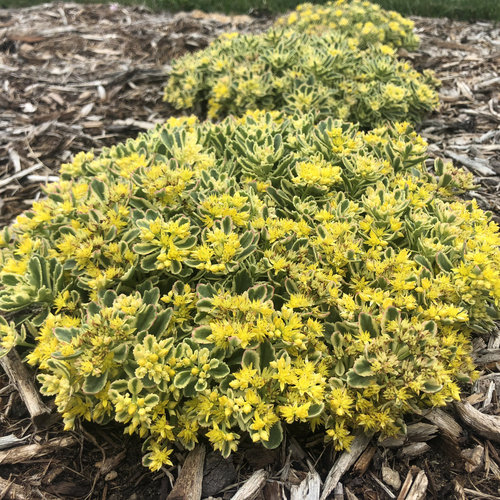 Rock ’N Low™ ‘Boogie Woogie’ has variegated dark green foliage edged with cream that offers a stunning backdrop to prolific clusters of bright yellow flowers. Grow this perennial groundcover along a rock wall, in curbside strips or containers, or as edging for pathways and mixed borders. |
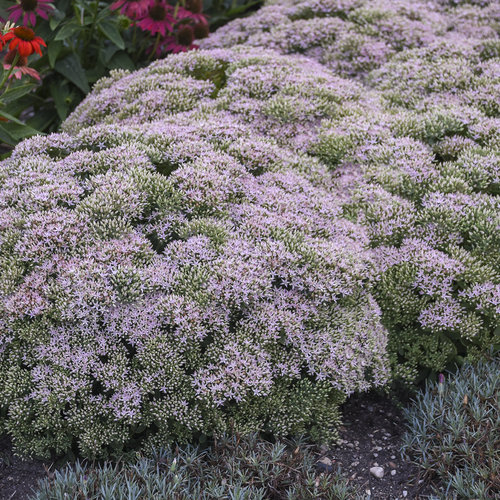 Rock ’N Round™ ‘Pure Joy’ produces neat mounds of green foliage that become completely smothered by tiny star-shaped flowers in late summer. The bubble-gum pink blooms fade to deep mauve seedheads for months of continuous color into fall and winter. Use for pathway or border edging, containers or mass plantings. |
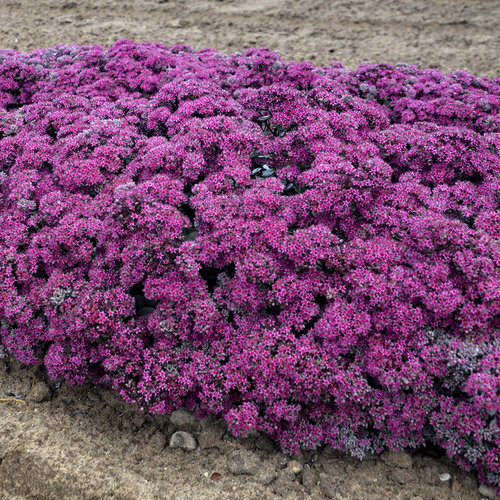 Rock ’N Round™ ‘Superstar’ has unusual dark turquoise foliage that contrasts with deep rose-pink flowers appearing from late summer to early fall. Use this compact mounding perennial to edge pathways and borders, or in mass plantings for beds or slopes. Blooms make long-lasting cut flowers in fresh or dried arrangements. |
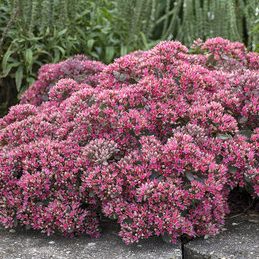 Rock ’N Round™ ‘Popstar’ has dense, dome-shaped mounds of blue-green foliage topped by salmon-pink flowers. Use this sophisticated perennial along rock walls, in mass plantings or to edge a mixed border. Dark pink seedheads provide continual interest long past its summer bloom. |
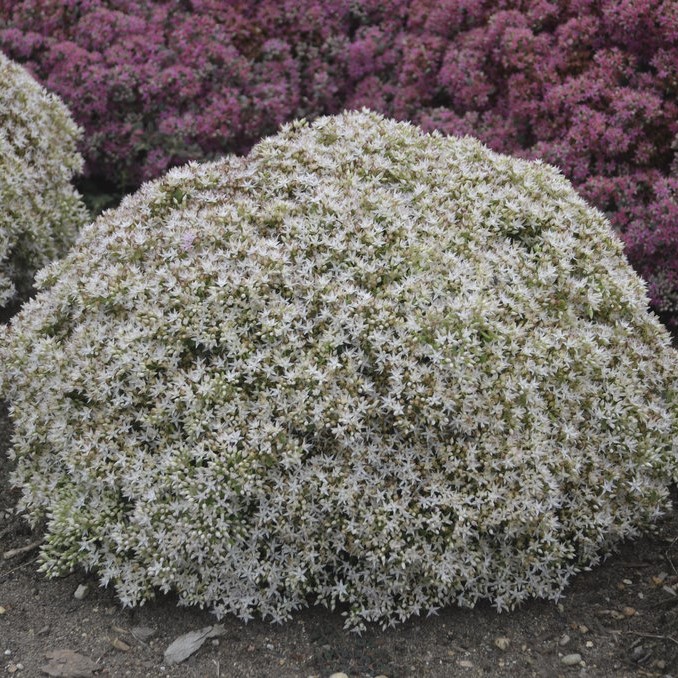 Rock ’N Round™ ‘Bundle of Joy’ forms neat low-growing mounds of green foliage with clean white flowers for an elegant appearance. This reliable hardy perennial goes with any style home or landscape. Use along pathways or massed in beds and mixed borders. |
 Rock ’N Low™ ‘Yellow Brick Road’ produces rich green leaves that are complemented by red stems. Finely textured golden yellow flowers bloom later in the growing season. Plant in a rock garden, mass along a slope or use as edging for pathways and borders. |
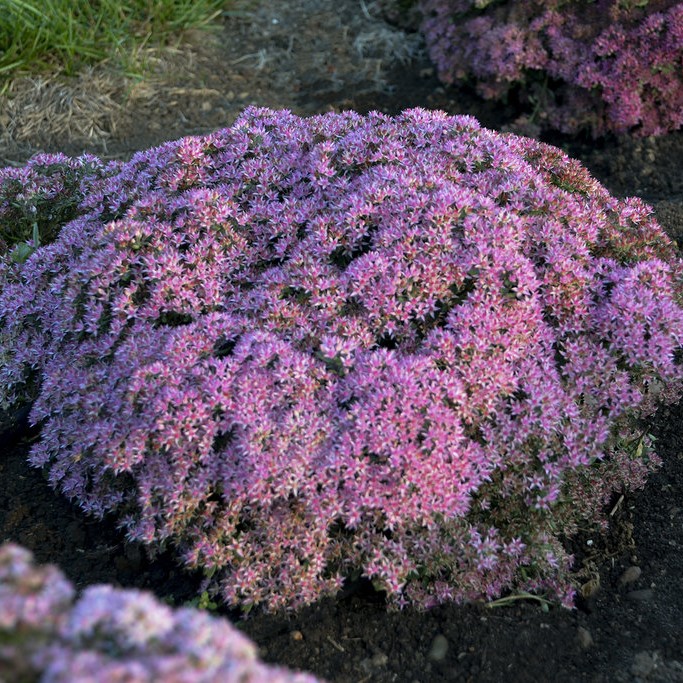 Rock ’N Round™ ‘Pride and Joy’, which is a sport of ‘Pure Joy’, has darker pink flowers and darker foliage than its parent, but with the same neat mounded habit. This variety is especially showy when massed in the landscape. Use for edging or as a rock garden specimen. |
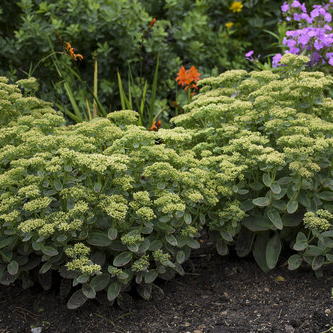 Rock ’N Grow® ‘Lemonjade’ boasts bright citron yellow flowers rather than the pink blooms typical of tall sedums. The seedheads take on rosy hues as the weather cools, adding to its intriguing appearance. Suitable for containers, beds or borders. Plant in combination with other fall-bloomers for a captivating late-season display. |
SEDUM FAQ’s
Do deer eat sedum?
Sedums are generally considered deer resistant because of the thick, fleshy leaf texture and bitter taste. Some varieties are more resistant than others. If other food is scarce, you may experience some deer browse.
Is sedum a perennial? Do they come back every year?
Most sedums are hardy long-lived perennials that come back reliably for many years. Some species are annuals or tender perennials in colder regions.
When does sedum bloom?
Creeping sedums typically bloom from early to late summer, while tall types flower from late summer into fall.
Does sedum spread?
Groundcover or creeping sedums can spread up to 2-3’ wide, while tall sedums stay more compact.
Do sedums die back in winter?
Tall sedums go dormant in winter, though their structure remains unless cut back. Many groundcover sedums stay evergreen through winter in milder climates, with some changing color when the weather gets cold.
Are sedum and stonecrop the same thing?
Sedum is used as both the botanical and common name. Sedum is also commonly known as stonecrop because of its stone-like appearance. Some sedums have been reclassified as Hylotelephium.
HOW TO USE SEDUM IN YOUR LANDSCAPE
Sedum is a versatile landscape plant. Here are some ideas on how to use them in your yard:
- Plant groundcover types along a rock wall, allowing them to spill over the edge
- Use tall varieties in combination with other drought-tolerant fall bloomers in a curbside strip
- Mass groupings of sedums along a pathway for months of color
- Plant groundcover types in-between paving stones
- Tall sedums can be planted at the front of a mixed border for fall color
- Adorn a stone trough with creeping sedums and other perennial ground covers
- Incorporate groundcover varieties with alpines and waterwise plants in a rock garden
- Mass tall sedums along a slope in combination with other low-maintenance plants
- Adorn a sunny deck or patio with a decorative container planted with different colored sedums
- Create a green roof garden using groundcover sedums for an eco-friendly display
COMPANION PLANTS
Many other plants complement sedum in the landscape. Here are some suggestions:
Combine tall sedums with other plants with fall interest such as:
- Quick Fire® panicle hydrangea
- Graceful Grasses® purple fountain grass
- Pow Wow Wild Berry coneflower
- ‘Little Goldstar’ black-eyed Susan
Groundcover sedums pair well with other drought-tolerant plants such as:
- Fire Spinner® hardy ice plant
- Coloropsis™ ‘Salsa’ tickseed
- ‘Blue Whiskers’ blue fescue
- ‘Violet Profusion’ perennial salvia
For carefree color all season long, plant a container with sedums and other low-water plants such as:
- Diamond Frost ® euphorbia
- Whirlwind® Blue fan flower
- Sweet Romance® lavender
- Fruit Punch® ‘Apple Slice’ pinks
Want to learn more?
10 Easy Foundation Plants
Fall-Blooming Perennials
12 Deer-Resistant Perennials




